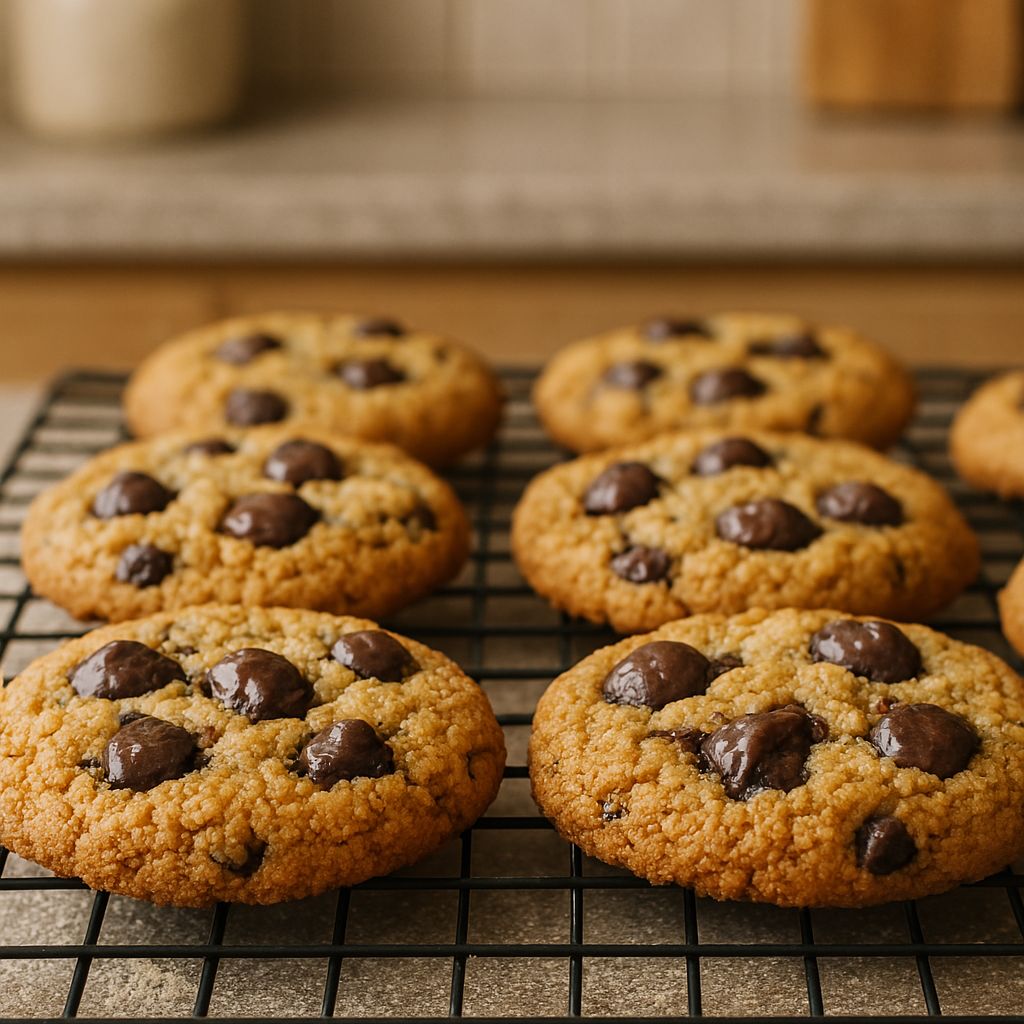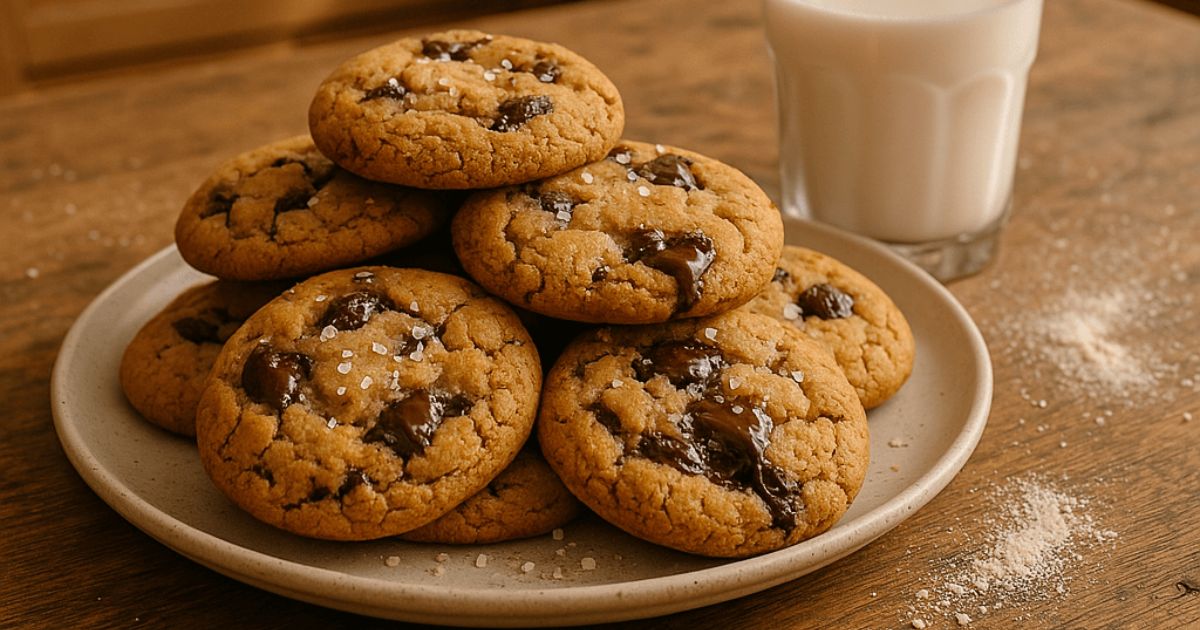Chocolate Chip Cookies with Almond Flour: 5 Easy Steps
Have you ever wondered if it’s possible to bake cookies that are just as soft, chewy, and delicious as the classic chocolate chip variety—without using regular flour? If you’re nodding your head or simply curious, you’re in for a treat! Today, we’re diving into a recipe that swaps out traditional all-purpose flour for almond flour. The result? A batch of mouthwatering Chocolate Chip Cookies with Almond Flour that are not only gluten-free but also packed with flavor and nutrients. Whether you’re looking for healthier alternatives, catering to dietary restrictions, or just eager to try something new, this recipe is perfect for you.
Table of Contents
Overview: Why These Cookies Are Special
What makes these Chocolate Chip Cookies with Almond Flour stand out is their unique texture and health benefits. Unlike traditional cookies, which can sometimes feel heavy or overly sweet, these cookies are light, buttery, and slightly nutty thanks to the almond flour. Plus, they’re quick to whip up—ready in under 30 minutes—and super beginner-friendly. Even if you’ve never baked before, you’ll find this recipe easy to follow.
Here’s a quick breakdown:
- Time Requirement: Prep time = 10 minutes; Bake time = 12–15 minutes; Total = ~25 minutes.
- Difficulty Level: Beginner-friendly (no fancy techniques required!).
- Special Features: Gluten-free, lower-carb option, rich in protein and healthy fats.
Ready to get started? Let’s dive into the details!

Essential Ingredients: The Building Blocks of Great Cookies
Before we jump into the steps, let’s talk about what goes into making these magical cookies. Here’s a list of the key ingredients and why they matter:
1. Almond Flour
- Why It Matters: Almond flour is the star of the show. It gives the cookies a soft, melt-in-your-mouth texture while adding a subtle nutty flavor. Plus, it’s naturally gluten-free and higher in protein compared to wheat flour.
- Substitutions: If you don’t have almond flour, you could use another nut-based flour like hazelnut flour. However, avoid substituting with coconut flour—it absorbs liquid differently and will ruin the texture.
2. Dark Chocolate Chips
- Why It Matters: High-quality dark chocolate chips provide bursts of sweetness without being overly sugary. They pair beautifully with the nuttiness of the almond flour.
- Substitutions: Feel free to swap in milk chocolate chips, chopped chocolate bars, or even sugar-free chocolate chips if you’re watching your sugar intake.
3. Unsalted Butter
- Why It Matters: Butter adds richness and helps create that irresistible chewy texture. Using unsalted butter allows you to control the saltiness of the cookies.
- Substitutions: For a dairy-free version, use coconut oil or vegan butter.
4. Eggs
- Why It Matters: Eggs act as a binding agent, holding the ingredients together. They also contribute to the cookies’ structure and moisture.
- Substitutions: Try flax eggs (1 tablespoon ground flaxseed mixed with 3 tablespoons water per egg) for an egg-free alternative.
5. Vanilla Extract
- Why It Matters: Vanilla enhances the overall flavor profile, giving the cookies warmth and depth.
- Substitutions: Almond extract works well too, especially since it complements the almond flour.
6. Coconut Sugar (or Brown Sugar)
- Why It Matters: Coconut sugar has a caramel-like taste and is less processed than white sugar. It also keeps the cookies moist.
- Substitutions: Regular brown sugar or granulated sugar works fine if you don’t have coconut sugar.
7. Baking Powder
- Why It Matters: This leavening agent ensures the cookies rise slightly, creating a soft and airy texture.
8. Salt
- Why It Matters: A pinch of salt balances the sweetness and brings out the flavors of the other ingredients.
Step-by-Step Instructions: How to Bake Your Cookies
Now comes the fun part—making the cookies! Follow these five simple steps to achieve cookie perfection.
Step 1: Preheat and Prep
- Preheat your oven to 350°F (175°C). Line a baking sheet with parchment paper or a silicone mat to prevent sticking.
- Gather all your ingredients and tools (mixing bowls, spatula, measuring cups, etc.). Having everything ready makes the process smoother.
Step 2: Cream the Butter and Sugar
- In a large bowl, cream together the softened butter and coconut sugar until light and fluffy. You can do this by hand with a whisk or use an electric mixer for speed.
- Add the vanilla extract and eggs one at a time, mixing well after each addition. This step creates the base of your cookie dough.
Step 3: Mix the Dry Ingredients
- In a separate bowl, whisk together the almond flour, baking powder, and salt. This ensures the dry ingredients are evenly distributed.
- Gradually add the dry mixture to the wet mixture, stirring gently until fully combined. Be careful not to overmix, as this can make the cookies dense.
Step 4: Fold in the Chocolate Chips
- Gently fold in the dark chocolate chips using a spatula. This step adds pockets of gooey goodness throughout the cookies.
- Optional: Reserve a handful of chocolate chips to press onto the tops of the cookies before baking for a bakery-style look.
Step 5: Scoop and Bake
- Use a cookie scoop or tablespoon to drop spoonfuls of dough onto the prepared baking sheet, spacing them about 2 inches apart.
- Flatten the dough slightly with the back of a spoon or your fingers (almond flour doesn’t spread much during baking).
- Bake for 12–15 minutes, or until the edges turn golden brown. The centers may still look soft, but they’ll firm up as they cool.
Assembly: Tips for Perfect Presentation

Once your cookies come out of the oven, let them cool on the baking sheet for 5 minutes before transferring them to a wire rack. Cooling prevents them from breaking apart and allows the flavors to settle.
For a professional touch:
- Press extra chocolate chips onto the warm cookies for a glossy finish.
- Sprinkle a pinch of sea salt on top for a sweet-and-salty twist.
- Serve with a glass of cold almond milk or coffee for the ultimate indulgence.
Storage and Make-Ahead Tips
These cookies stay fresh for up to 5 days when stored properly. Here’s how to keep them tasting great:
- Room Temperature: Store in an airtight container at room temperature.
- Refrigerator: Keep them chilled for longer freshness, especially in warmer climates.
- Freezer: Freeze unbaked dough balls for up to 3 months. Simply thaw and bake whenever you crave fresh cookies!
To reheat, pop a cookie in the microwave for 10–15 seconds for that just-baked warmth.
Recipe Variations: Get Creative!
Feel free to experiment with these ideas to customize your cookies:
- Nut Lovers: Add chopped walnuts, pecans, or macadamia nuts for extra crunch.
- Fruit Fans: Swap some chocolate chips for dried cranberries or cherries.
- Spice It Up: Add a teaspoon of cinnamon or a dash of nutmeg for a cozy fall vibe.
- Double Chocolate: Stir in cocoa powder for a decadent double-chocolate version.
Conclusion: Time to Bake and Enjoy!
There you have it—a foolproof guide to making Chocolate Chip Cookies with Almond Flour that are as tasty as they are healthy. With their rich flavor, soft texture, and versatility, these cookies are sure to become a staple in your kitchen. Don’t be afraid to tweak the recipe to suit your tastes—you might discover a new favorite combination!
So grab your apron, preheat that oven, and get ready to wow your family and friends (or just yourself!) with these delightful treats. Happy baking!
FAQs: Your Burning Questions Answered
Q: Are these cookies gluten-free?
A: Yes! Since almond flour is naturally gluten-free, these cookies are safe for those avoiding gluten.
Q: Can I use honey instead of coconut sugar?
A: While honey can work, it will change the texture of the cookies. Stick with dry sweeteners like coconut sugar or brown sugar for best results.
Q: Do I need to chill the dough?
A: Not necessarily. Almond flour dough doesn’t require chilling, but if you prefer firmer cookies, chilling for 15–30 minutes won’t hurt.
Q: Are these cookies keto-friendly?
A: Absolutely! With almond flour and dark chocolate chips, these cookies fit perfectly into a low-carb or keto diet.
Q: Why did my cookies turn out flat?
A: Flat cookies usually happen due to overmixing the dough or skipping the flattening step before baking. Remember, almond flour doesn’t spread much, so shaping the dough is key.







